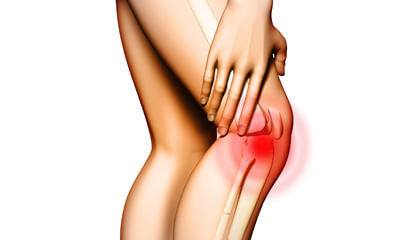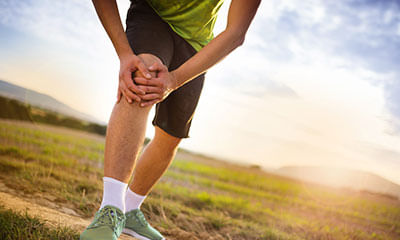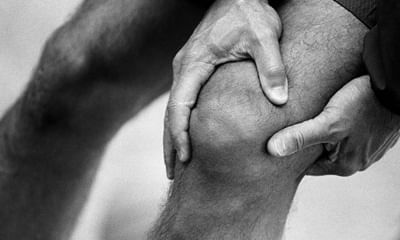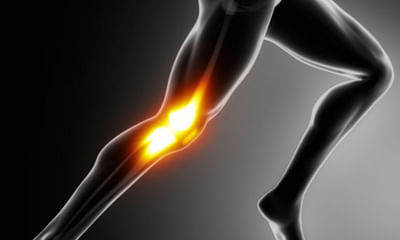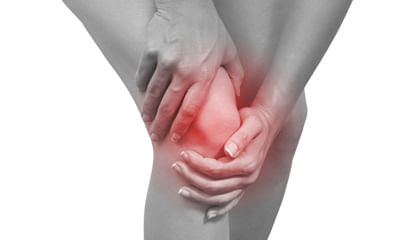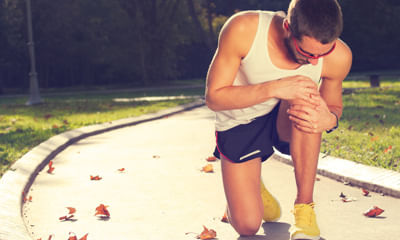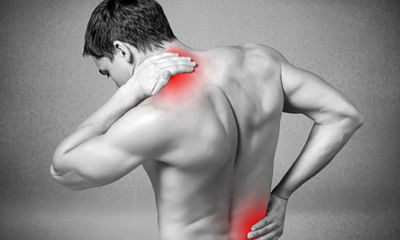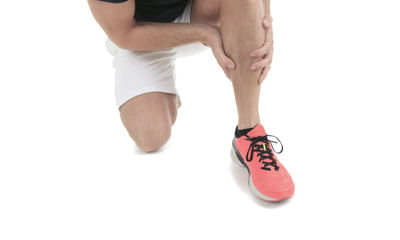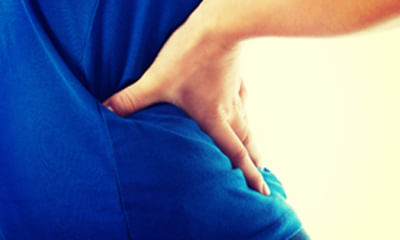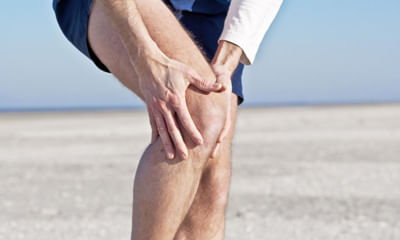Pain In Foot After Knee Surgery
Im a footballer who got a meniscus tear and got recovered has pain when I bends my right knee but without having the bod ...
Ask Free Question
You may still be experiencing some residual issues related to your meniscus tear, even though you have recovered from the initial injury. The specific symptoms you described, such as pain when bending the knee while sitting and needing to tighten your calf to feel the pain, suggest that there may be ongoing irritation or inflammation in the knee joint. One possibility is that you could be experiencing a condition called "meniscal irritation" or "meniscal impingement. This occurs when the torn edge of the meniscus rubs against other structures in the knee joint, causing pain and discomfort, particularly during activities that involve bending the knee. Another possibility is that you may have developed some scar tissue or adhesions in the knee joint as a result of the initial injury and subsequent healing process. This scar tissue can sometimes cause stiffness and discomfort, especially with certain movements like bending the knee while sitting. It's important to have your knee evaluated by a healthcare professional, preferably one specializing in sports medicine or orthopedics. They can perform a thorough examination, possibly including imaging studies like an mri, to determine the exact cause of your symptoms and recommend an appropriate treatment plan. This may include physical therapy to improve flexibility and strength, specific exercises to address any imbalances or weaknesses, and possibly further interventions such as injections or, in some cases, surgery to address any ongoing issues with the meniscus or other structures in the knee joint.
Hi. How strong is generally reconstructed acl after 8 months of surgery, yesterday 1 of the kids aged 7-8 years old fell ...
Ask Free Question
After acl reconstruction surgery, it typically takes several months for the graft used to replace the torn ligament to heal and integrate with surrounding tissues. During this time, the new acl graft is gradually remodeling and strengthening, but it may not reach its maximum strength until about 12 to 18 months post-surgery. The strength of the reconstructed acl can also depend on factors such as the type of graft used (e.g. Autograft or allograft), surgical technique, rehabilitation protocol, and individual factors such as age, overall health, and adherence to post-operative rehabilitation. In general, after 8 months of surgery, the reconstructed acl may have regained a significant amount of strength and stability, but it may still be vulnerable to sudden forces or impacts, especially during activities involving twisting, pivoting, or direct blows to the knee. If you experienced a fall or trauma to your operated leg, it's essential to monitor for any new or worsening symptoms such as pain, swelling, instability, or decreased range of motion. If you have any concerns or if you experience significant pain or instability, I would recommend consulting with your orthopedic surgeon or healthcare provider for a thorough evaluation to assess the integrity of the reconstructed acl and determine if any further treatment or precautions are necessary. They can provide personalized guidance based on your specific situation and help ensure the best possible outcome for your recovery.
Hi I had acl surgery with bio screw hamstring and it's been 8 weeks now. I am not able to fully extend my knee differenc ...
Ask Free Question
Knee ligament laxity if you have problem in your legs then it might be due to ligament laxity where your legs would become very weak due to the old ligament injury and that should be treated immediately. Wear knee cap so that you will feel firm while walking or climbing stairs. This is a general strain and for this you can follow these measures: one keep a pillow right under the knee while sleeping, next is you can keep ice in the painful area for about 5--10 minutes, if pain still persists you can stretch your body by twisting the waist on both sides how we used to do in the school drill similarly you can try! one time you can do hot water fermentation that would help to reduce the muscle strain. You have to do knee strengthening exercises, ie. Knee rehabilitation exercises which will strengthen your knee. Exercises will give you permanent cure than the surgery. Physiotherapy management :you can take ultrasonic therapy in one of the nearby physiotherapy clinics which would help to heal the damaged cartilages along with shortwave diathermy which would help to improve the blood circulation. Knee pain: resisted terminal knee extension: make a loop with a piece of elastic tubing by tying a knot in both ends. Close the knot in a door at knee height. Step into the loop with your injured leg so the tubing is around the back of your knee. Lift the other foot off the ground and hold onto a chair for balance, if needed. Bend the knee with tubing about 45 degrees. Slowly straighten your leg, keeping your thigh muscle tight as you do this. Repeat 15 times. Do 2 sets of 15. If you need an easier way to do this, stand on both legs for better support while you do the exercise. Standing calf stretch: stand facing a wall with your hands on the wall at about eye level. Keep as arthritis is very common that you get generally bilaterally. Ice therapy would definitely help to reduce the inflammation. We also advise you to use knee cap which would help to prevent the knee from damaging further and also to maintain the quadriceps muscle tone knee pain, when leg folding time get pain. This must be due to your muscular strain and posture and it may not be due to any other reasons. It is better to correct your addictive behaviour by consulting the right physician. For the time being for the back pain, apply ice.Neck tilt: from the sitting position, tilt your head down so your chin touches your chest. Hold this position for 5 second s. Return to the starting position and repeat. Do this five times. Side-to-side neck tilt. From the same starting position, tilt you neck toward one shoulder, leading with your ear. Hold for 5 seconds and then return to the starting position. Do this five times on each side. Neck turn. Look straight ahead, then turn your head to one side, keeping your chin at the same level. Do this five times on each side. Neck stretch. Holding the rest of your body straight, push your chin forward, stretching your throat. Hold for 5 seconds. From the same starting position, push your chin backward and hold for 5 seconds. Do the forward and backward stretch five times each. If any of these exercises cause severe pain or weakness in your hands or arms, stop right away and talk with your doctor the importance of buying braces and splints from us – orthopaedic support braces we suggest you to wear knee brace which is available at our clinic. If you want you can buy from us, if you are far away from chennai we can send you by courier. The reason why we are conveying you to buy from us is we can demonstrate over the videocall (using whatsapp) and also we can monitor you throughout when to wear it and how long to wear it. And also if you find any difficulty wearing the brace you can also revert back to us for few more suggestions and we can propose you good solution how to go about it.
My mother is 56 years old. She has been suffering with knee joints pain from last 9 years. Doctor says for knee replacem ...
Ask Free Question
Diabetes and knee replacement: diabetes can increase the risk of complications during surgery, including knee replacement surgery. However, many people with well-controlled diabetes can undergo knee replacement surgery safely. It's essential for your mother to discuss her diabetes management with her healthcare provider and the orthopedic surgeon who will perform the knee replacement. They will assess her overall health and determine if she is a suitable candidate for surgery. Close monitoring of blood sugar levels before and after surgery will be important to minimize the risk of complications. Numbness in feet: numbness and tingling in the feet can be symptoms of diabetic neuropathy, a common complication of diabetes that affects the nerves. It's important for your mother to have a thorough evaluation by a healthcare provider to assess her symptoms and determine the underlying cause. Additional tests, such as nerve conduction studies or electromyography (emg), may be recommended to evaluate nerve function. Shoulder, arms, and legs pain: pain in the shoulders, arms, and legs can have various causes, including arthritis, nerve compression, muscle strain, or other musculoskeletal conditions. Your mother may benefit from a comprehensive evaluation by a healthcare provider, possibly including imaging studies such as x-rays or mri, to determine the cause of her pain and develop an appropriate treatment plan. Comprehensive check-up: to address your mother's multiple symptoms and concerns, it's important for her to undergo a comprehensive medical evaluation. This may include: blood tests: to assess blood sugar levels, kidney function, lipid levels, and other metabolic parameters. Nerve function tests: to evaluate for diabetic neuropathy or other nerve-related issues. Imaging studies: such as x-rays, mri, or ultrasound to assess the condition of the knee joints, shoulders, and other affected areas. Consultations with specialists: such as an orthopedic surgeon, endocrinologist (for diabetes management), or neurologist (for nerve-related issues). Holistic approach: given your mother's multiple symptoms and medical conditions, a holistic approach to her care may be beneficial. This could include optimizing diabetes management, incorporating physical therapy or exercise programs to improve mobility and strength, and exploring options for pain management and symptom relief.
My mother is 70 years old, and she had knee pain and one knee surgery done before 6 months. Also she have back pain, nec ...
Ask Free Question
You can take her to physiotherapy clinic and ask them for traction for the lower back for 5 days with swd after 5 days, ift+us therapy for 10 days. In about 2 weeks the pain and the compressions will be reduced. Alternatively if you can get pemf therapy it will be more helpfull in reducing pain. Same ift+us therapy can be given to neck to reduce pain and relaxing the muscles.
I have been having left hip pain I can not do internal r9tation to wear socks and its everyday pain I went to do xray an ...
Ask Free Question
Follow these herbal combinations for complete cure vrihad vat chintamani ras 1 tablet twice a day vatari awleh 10 gm twice a day vyadhi har rasayan 125 mg twice a day.
Plz help me from the pain! I am having pain at l5-s1 level and severe pain to my left leg due to which I am completely o ...
Ask Free Question
Herniated disc 1. Spinal decompression how it helps – spinal decompression should be the very first thing you do to treat a herniated or bulging disc because it essentially creates space between your vertebrae, and thus takes pressure off the discs. How to do it – use a bar or the top of a door (or anything you can hang from) and allow your body to “just hang”. – hang for 30 seconds and do 3 sets. – release very slowly from this so as not to cause any spasms. ** this should not cause any pain. If you feel pain during it is not a good one for you. In that case, stop and try some of the other exercises below instead. 2. Standing extension how it helps – this standing extension helps reverse what you do on a daily basis (hunching)… since most bulging discs and herniated discs are caused by poor posture and repeated flexion of the spine (esp bending fwd in bad posture), this stretch helps push the disc back to neutral position. How to do it – begin this exercise by standing up with good posture. Now take both hands and place them on both sides of your lower back. Now with the help of your hands push your pelvis forward and extend your spine back. Follow the extension with your neck so that you end up facing the ceiling. – start with 10 repetitions and do 2-3 sets. – this one is particularly great to do when you need a break from sitting at your desk. ** this should not cause any pain. If you feel pain during it is not a good one for you. In that case, stop and try some of the other exercises below instead. 3. Half cobra pose (prone lumbar extension) how it helps – the half cobra stretch helps to push the disc material back towards the center of the inter-vertebral disc to allow for improved healing. The goal of repeated lower back extension is the “centralization of symptoms”, which basically means pain that travels down the affected leg to the foot should come back up closer to the low back – which will in turn alleviate the pain. How to do it – begin this exercise by lying on your stomach (prone position) and slowly prop yourself up on your elbows while keeping your hips in contact with the floor. – hold the prop-up position for 10-15 seconds before returning to the prone position (lying face down). – gradually increase to holding the end position for 30 seconds. Aim for 10 repetitions of this stretch. ** initially, you may not be able to tolerate this position very well, so make sure you start slowly and carefully. If there’s any pain, try a different exercise instead. 4. Full cobra pose (advanced extension) how it helps – this stretch is based on the same principle as the half cobra pose above. This advanced extension helps to push disc material back towards the center of the intervertebral disc, with the goal of alleviating pain symptoms. How to do it – once you’ve mastered the half cobra pose, you can increase the difficulty by moving to the advanced version of this stretch. Begin this exercise by lying on your stomach in the prone position (lying facing down) and slowly press up on your hands while keeping your pelvis in contact with the floor and lower back relaxed. – hold the prop-up position for 10 seconds. Aim for 10 repetitions of this stretch. – eventually try to hold this pose for longer if it feels good (20-30 seconds). ** if you feel pain during this exercise, it is not a good one for you. In that case, stop and try some of the other exercises instead. 5. Cat-cow how it helps – this is one of the most popular herniated disc exercises. By combining two yoga poses, the cat-cow stretch can help to relieve pressure on the herniated disc by opening the intervertebral disc space. It also improves mobility of the spine, which may help to relieve disc herniation pain and speed recovery. How to do it – begin this stretch on your hands and knees. Inhale and let your stomach “drop” towards the floor as you look up towards the ceiling. – follow this by exhaling and slowly rounding your spine while pressing into the floor with your hands and slightly curving your neck to look at your feet. – aim for 10 repetitions of this stretch and do 2-3 sets. How it helps – this exercise will help strengthen and stabilize your lower back and deep spine muscles. This will help you to maintain a good posture and avoid future episodes of herniated discs. How to do it: – begin on your hands and knees with your hands positioned under your shoulders and knees positioned under your hips. – raise your left arm and reach it forwards until it is aligned with your torso; at the same time, kick your right leg backwards until is it aligned with your torso. – hold this position for 2-3 seconds before slowly returning to the starting position. – repeat with your right arm and left leg. – alternate sides for 10 repetitions and do 2-3 sets. ** ensure that your head, neck, and back maintain a neutral alignment to minimize stress on your neck. 6.plank: how it helps – just like the bird dog, this “core” exercise will help bring your pelvis into right position by strengthening the deep spinal muscles and glutes (butt muscles). How to do it – begin lying on your stomach with your forearms against the mat. – engage your core and lift your body so that you are resting on your forearms and toes. – start with 10 second holds and work up to 30 second holds, do 2-3 sets. ** ensure to keep your back straight throughout the entire exercise – spine in neutral position. Thoracic expansion if you’re using a chair, sit facing forward and allow your upper body to fall over the back of the chair. Extend your arms above your head for a deeper stretch. Hold either position for 10 seconds and release. Repeat 3 times. 7.sitting spinal stretch sciatica pain is triggered when vertebrae in the spine compress. This stretch helps create space in the spine to relieve pressure on the sciatic nerve. 1.sit on the ground with your legs extended straight out with your feet flexed upward. 2.bend your right knee and place your foot flat on the floor on the outside of your opposite knee. 3.place your left elbow on the outside of your right knee to help you gently turn your body toward the right. 4.hold for 30 seconds and repeat three times, then switch sides. 8. Standing hamstring stretch this stretch can help ease pain and tightness in the hamstring caused by sciatica. 1.place your right foot on an elevated surface at or below your hip level. This could be a chair, ottoman, or step on a staircase. Flex your foot so your toes and leg are straight. If your knee tends to hyperextend, keep a slight bend in it. 2.bend your body forward slightly toward your foot. The further you go, the deeper the stretch. Do not push so far that you feel pain. 3.release the hip of your raised leg downward as opposed to lifting it up. If you need help easing your hip down, loop a yoga strap or long exercise band over your right thigh and under your left foot. 4.hold for at least 30 seconds, and then repeat on the other sideif you have low back pain and sciatica you can undergo intermittent pelvic traction where in your half of your body weight will be added in the electronic traction so that that would help you to reduce the pain, along with interferential therapy stimulations which would help you to get relieved from the radiating pain. 9.anterior pelvic tilt 1.lie on the back with the knees bent and feet flat on the floor, hip-width apart. 2.squeeze the buttocks and tilt the pelvis upward. 3.the back should feel as though it is flattening to the ground. 4.return to normal pelvis position. 5.repeat 10–12 times. Apply ice for the pain to get subsided immediately. If you cannot go immediately for the physiotherapy treatment. Ice can be kept in the low back where you have back pain. It is suggestible to wear lumbo sacral belt which would help you to build the abdominal muscle tone which itself would make you feel better. You can also wear mcr chappals which would help you to have less weight falling in the painful back. U have to take vitamin d rich foods. Likemilk, cheese, yogurt, brocoli, spinach. U need calcium consumption for increase the bone density. Lackof bone and bones crush inside the body vitamin d intake via supplements or exposure to low levels of sunlight. Vitamin d is used to absorb calcium in the bone and regulate calcium in the blood.this might be due to low calcium or vitamin d which has more impact on the bone density and also it makes one to feel that there is lack of bone strength or in a way the bones are brittle and almost breaking and they feel it is crushed in a way there are many bones breaking at the same time. You have to take vitamin d rich foods. Likemilk, cheese, yogurt, brocoli, spinach. U need calcium consumption for increase the bone density.
Hi I had acl and meniscus surgery 7 months back I can bend my leg only till 100 degrees should I get re surgery for stil ...
Ask Free Question
Acl rehab exercises for when your knee is still fragile here are three of the best (and safest) exercises to treat an acl injury when first starting out: • heel slides involve the extension of the knee without bearing any weight. Start by sitting on the floor with your legs outstretched. Slowly bend the injured knee while sliding your heel across the floor toward you. Slowly slide the foot back into the starting position and repeat 10 times. • isometric contractions of the quads are also done seated. For this, you would need to sit on the floor with your injured leg extended and your other leg bent. Now slowly contract the quadriceps of the injured knee without moving the leg and hold for 10 seconds. Relax. Repeat 10 times. • prone knee flexion involves lying on your stomach with your legs straight. Now bend your injured knee and bring your heel toward your buttocks. Hold five seconds. Relax. Repeat 10 times. When first starting, forget the adage "no pain, no gain. While you will likely experience discomfort when exercising the quads and hams, back away from any movement that causes outright pain. Pushing too hard can make matters worse and result in lengthier recovery time. Acl rehab exercises for after the swelling subsides as the swelling of your knee begins to subside, you should gradually be able to stand squarely on both feet without favoring the uninjured leg. When you are fully able to do this, you can start adding the following exercises: • passive knee extensions require two chairs of equal height. Place the chairs facing each other at a distance slightly shorter than the length of your leg. Sit in one chair and place your heel on the seat of the other. Relax your leg and allow your knee to straighten. Rest in this position one to two minutes several times a day to gradually stretch out the hamstrings. • heel raises are done while standing. Start by placing one hand on the back of a chair for balance. Now slowly lift the heel of your injured leg up, standing on your tiptoes. Stay there for five to 10 seconds. Slowly lower your heels. Repeat 10 times. • half squats are done standing while holding a sturdy table with both hands. Placing your feet a shoulder’s width apart, slowly bend your knees and lower your hips into a half squat. Hold for 10 seconds and then slowly return to a standing position. Repeat 10 times. • knee extensions require either a theraband or a length of an exercise band. To begin, loop one end of theraband around the leg of the table and the other around the ankle of your injured leg. (alternately, tie both ends of the exercise band around the table leg and insert the ankle of your injured leg into the looped end.) facing the table, slowly bend your knee about 45 degrees against the resistance of the tubing. Hold for a few seconds and slowly return to a standing position. Repeat 10 times. • standing on one leg is a great way to build and evaluate your strength and balance. Do so by lifting the uninjured leg and standing unassisted on the injured leg for 10 seconds. This exercise may not be so easy at first, but, with time and patience, you should able to do so while a few weeks.
I have a question please. If someone has rounded shoulders and an anterior pelvic tilt, will it make them shorter, and b ...
Ask Free Question
1.cat-camel on hands and knees, maintain tight abdominals with head straight (photo 1). Take a deep breath in and lift your lower rib cage, round your back and relax your neck (photo 2). As you breathe out, lower your chest towards the floor, looking slightly upward. Return to beginning position with tight abdominals. Repeat ten (10) times per set. Do two (2) sets per session. Do one (1) session per day. •bracing. Bracing may prevent a spinal curve from getting worse, reduce pain, and improve mobility. The right bracing strategy depends on the type of scoliosis a person has, so talk to a doctor before trying a brace. •choosing the right furniture. An ergonomic chair or mattress may better support the spine and back, reducing pain. •massage. Some people find that massage helps with scoliosis pain 2.plank the world record for the longest plank is 8 hours. Luckily, you don’t need to hold it that long for the exercise to have an effect! in fact. You can hold it for 10-15 seconds. •the plank is similar to a push-up position, but instead of resting on your hands, you rest on your elbows and bring them directly underneath your chest. •after kneeling, lean forward and place your elbows on the ground directly below your shoulders. •lift your knees off of the floor and push your feet back. Ensure your back is straight and keep your neck aligned with the rest of your spine. •hold the position and tighten your core muscles for the desired time. 3. Side plank just like the original plank, but only balancing on one side. •lie on the floor on your side, facing sideways with your feet together. •lift up your body until you are supporting yourself with your elbow, directly below your shoulder. •raise your hips until your body is in a straight line and tighten your core muscles; your body should create a slant from your shoulders to your feet. •hold this position without dropping your hips. •repeat on the opposite side. 4. Pelvic tilt with exercise ball sit on a ball that allows your legs to be at a 90-degree angle with your feet flat on the floor. •keep your shoulders back and spine straight. •tilt your hips forward and flex your abdominals tight. •tilt your hips backward as you stick your tailbone out. •move back and forth slowly, keeping your shoulders back. •repeat 10 times for 3 sets. 5. Superman lie on your stomach, face down, with your arms out in front of you. •lift arms, legs, and chest off the floor simultaneously while keeping your hips grounded. •hold for a minimum of two seconds. •lower back down slowly. •repeat 10 times for 3 sets. 6.Crunches lie flat on your back, placing your feet flat on the floor with your legs bent. •fold your arms across your chest and lift your torso up until your head, neck, and torso are off the ground. •hold for a moment before lowering back down. •repeat. 7. Quadruped arm opposite leg raises •kneel on the floor, lean forward, and place your hands palm-down on the floor. •make sure your back is straight, your knees are below your hips, and that your palms are directly below your shoulders. •raise one arm as you raise the opposite leg until both are aligned straight out from your body, parallel to your spine. •slowly lower both your arm and leg until you are back in the starting position. •switch arm and leg, and repeat. 8. Dead bug lie flat on the floor on your back. •lift your arms straight up from your body, reaching through the air. •raise one leg until it is at a 90-degree angle from your body. •slowly lower until it is in the starting position. •switch legs and repeat. 9. Hip bridge lie on your back with your knees bent and raised, your feet flat on the floor, and your arms at your sides. •keep your feet hip-distance apart and try to keep your leg in vertical alignment with your knee. •flex your glutes and push through your heels to raise your hips upward. Try to make a diagonal line from your shoulders to your knees. •hold for a short moment before lowering back down. •repeat 10 times for 3 sets.
I have a bucket handle meniscus tear and an acl tear. I can keep my knees straight but I cannot walk. My doctor is recom ...
Ask Free Question
Meniscus injury a torn meniscus can result from any activity that causes you to forcefully twist or rotate your knee, such as aggressive pivoting or sudden. What are 3 signs of a meniscus injury? Swelling or stiffness. Pain, especially when twisting or rotating your knee. Difficulty straightening your knee fully. Feeling as though your knee is locked in place when you try to move it. Typically, mild meniscus tears heal within two to three weeks. What is a meniscal injury? A meniscus tear is an injury to a part of your knee called the meniscus and is a common injury. The menisci are two crescent-shaped pads of thick, rubbery shock-absorbing cartilage in your knee joint. They lie between your thigh bone (femur) and your shin bone (tibia). In the case of meniscus tears, some people think the injury will heal over time on its own. But the truth is that there are different types of meniscus tears — and some tears won't heal without treatment. If your tear is on the outer one-third of the meniscus, it may heal on its own or be repaired surgically. If your doctor has told you that you don't need surgery to repair your torn meniscus, you may be given the green light to walk. However, you'll want to be very careful about movements that might worsen the tear or cause you pain. Avoid squatting and pivoting, which are likely to place too much pressure on the knee. To speed the recovery, you can: 1.Rest the knee. 2.Ice your knee to reduce pain and swelling. 3.Compress your knee. 4.Elevate your knee with a pillow under your heel when you're sitting or lying down. 5.Take anti-inflammatory medications. 6.Use stretching and strengthening exercises to help reduce stress to your knee. Will a knee brace help a torn meniscus? Yes. Although knee braces do not heal or treat your meniscus tear directly, they can provide extra support and stability for your knee while your meniscus injury heals. A good brace will protect your knee and take the pressure off your meniscus, allowing it to rest. Your doctor may recommend the rice regimen—rest, ice, compression, and elevation—to treat a meniscus tear. Resting your knee can help relieve your symptoms. Your doctor may suggest using a cane for a few weeks to keep weight off your knee and to stay away from physical activity that may have contributed to the injury. Steps to heal a torn meniscus naturally: rest: it's crucial to rest your knee after injury. You should not participate in activities where you could cause additional strain. Ice: apply ice to your knee for 15 minutes at four-hour intervals.

